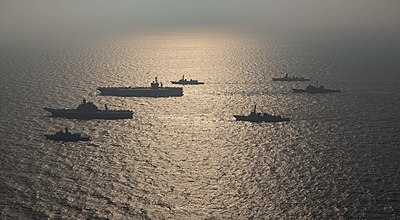
Exercise Malabar[a] is a naval exercise involving the United States, Japan and India as permanent partners.[1] Australia rejoined the exercise in 2020. The annual Malabar exercises includes diverse activities, ranging from fighter combat operations from aircraft carriers through maritime interdiction operations, anti-submarine warfare, diving salvage operations, amphibious operations, counter-piracy operations, cross–deck helicopter landings and anti–air warfare operations.[2][3] Over the years, the exercise has been conducted in the Philippine Sea, off the coast of Japan, the Persian Gulf, in the Bay of Bengal and the Arabian Sea. It is taken care by the Asian and the North American Commands.[4]
The exercise started in 1992 along the Malabar Coast as a bilateral exercise between India and the United States. It was expanded in 2007 with the participation of Japan, Singapore and Australia. Japan became a permanent partner in 2015. Since 2020, Australia participated in the exercise again, marking the second time that the Quad will be jointly participating in a military exercise.[5][6] The aim of the exercise includes increasing interoperability between the naval forces.
The duration of the exercise has ranged from 1 to 11 sea-days.[7] The complexity and sophistication of the exercise has increased over the years.[8] Exercises have on-shore and at-sea stages.[9] The average participation by India increased from 8 ships to just over 9 from 2002 to 2014.[8]
Exercises have included aircraft carriers (USS Nimitz, Kitty Hawk, Ronald Reagan, George Washington, INS Vikramaditya, Viraat), helicopter carriers (JS Kaga, Izumo, Ise, Hyūga), frigates, submarines (diesel-electric and nuclear), destroyers, guided-missile vessels, cruisers, amphibious ships and auxiliary ships such as tankers. Coast guard vessels have also taken part. Aircraft have included the P3C Orion,[10] Poseidon P8I,[11] Tupolev Tu-142,[12] Kawasaki P-1,[13] ShinMaywa US-2,[14] F/A 18 Super Hornets, Jaguars, Sea Harrier jets and Sea King helicopters.[6][15] Special forces have also taken part.[16]
Cite error: There are <ref group=lower-alpha> tags or {{efn}} templates on this page, but the references will not show without a {{reflist|group=lower-alpha}} template or {{notelist}} template (see the help page).
- ^ Gady, Franz-Stefan (5 June 2018). "India, US, and Japan to Hold 'Malabar' Naval War Games This Week". The Diplomat. Archived from the original on 13 June 2018. Retrieved 5 June 2018.
- ^ "Military Exercises –– Feb to Nov 2008. Indo–US Bilateral Naval Exercise – Malabar 08". indiadefence.com (India Defence Consultants). 17 November 2008. Archived from the original on 19 December 2008. Retrieved 28 November 2008.
- ^ Khurana, Gurpreet S (5 August 2014). "India-US MALABAR Naval Exercises: Trends and Tribulations". National Maritime Foundation. Retrieved 5 November 2020.
- ^ "Malabar 2020 Naval Exercise". Press Information Bureau, Government of India. Ministry of Defence. 19 October 2020. Retrieved 5 November 2020.
{{cite web}}: CS1 maint: others (link) - ^ "Malabar Drill: India, US, Japan and Australia kick off Malabar drill; China reacts". The Times of India. 3 November 2020. Retrieved 5 November 2020.
- ^ a b Cite error: The named reference
sksamwas invoked but never defined (see the help page). - ^ Pant, Harsh V.; Mann, Anant Singh (14 August 2020). "India's Malabar Dilemma (ORF Issue Brief No. 393)". Observer Research Foundation. Retrieved 7 November 2020.
- ^ a b Joshi, Shashank (9 October 2015). "Malabar: Modi Government misses an opportunity as annual exercise slumps". Lowy Institute. The Interpreter. Retrieved 14 October 2021.
- ^ Smith, Jeff M. (2014). Cold peace: China-India rivalry in the twenty-first century. Lanham, Maryland : Lexington Books. pp. 182–186. ISBN 978-1-4985-2092-8 – via Internet Archive.
- ^ Cite error: The named reference
IndianDefence101808was invoked but never defined (see the help page). - ^ Cite error: The named reference
:0was invoked but never defined (see the help page). - ^ Cite error: The named reference
:17was invoked but never defined (see the help page). - ^ "Exercise Malabar 2019". Indian Navy. Archived from the original on 26 September 2019. Retrieved 26 September 2019.
- ^ Cite error: The named reference
in14was invoked but never defined (see the help page). - ^ Cite error: The named reference
is9jwas invoked but never defined (see the help page). - ^ Cite error: The named reference
:18was invoked but never defined (see the help page).
© MMXXIII Rich X Search. We shall prevail. All rights reserved. Rich X Search


